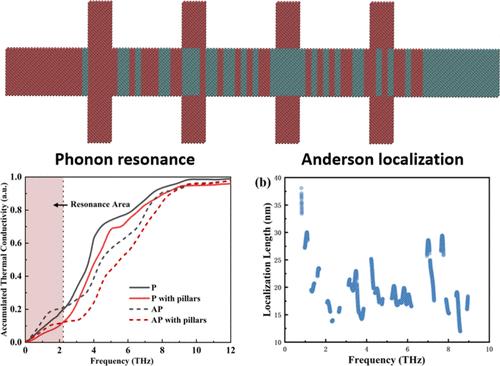Synergistic Effects of Phonon Anderson Localization and Resonance in Si/Ge Superlattice Nanowires: Toward Lower Thermal Conductivity
IF 3.2
3区 化学
Q2 CHEMISTRY, PHYSICAL
引用次数: 0
Abstract
Manipulating heat transfer in thermal functional materials is of great importance, with wide applications such as thermoelectrics, thermal management devices, thermal insulating materials, and thermal diodes. To influence the phonon propagation in nanostructures, Anderson localization and phonon resonance are commonly employed methods due to the wave nature of phonons. In this study, we investigate the thermal transport in Si/Ge superlattice nanowires incorporating aperiodic interfaces and resonance pillars, wherein Anderson localization and phonon resonance are simultaneously introduced. In superlattice nanowires with aperiodic interfaces, the thermal conductivity initially increases with size and then decreases, suggesting the occurrence of phonon Anderson localization when sufficient random interfaces are present. The reduction in the thermal conductivity caused by Anderson localization reaches 55.6% at a nanowire length of 109 nm. On the other hand, introducing phonon resonance via resonance pillars to the superlattice nanowires results in a reduction of 39.7% at the same nanowire length. The coexistence of Anderson localization and phonon resonance leads to a much more significant reduction of 62.6% in the thermal conductivity. Furthermore, we reveal that Anderson localization predominantly affects phonons in the medium-low frequency range (1.5–3.5 THz), while phonon resonance impacts phonons at low frequencies (0–2.2 THz). These two methods collaboratively impede phonons with different frequencies, thereby achieving exceptionally low thermal conductivity. Our findings provide new insights into regulating the thermal conductivity of materials through the wave nature of phonons.

硅/锗超晶格纳米线中声子安德森局域化和共振的协同效应:迈向低导热性
控制热功能材料中的传热是非常重要的,在热电、热管理器件、热绝缘材料和热二极管等领域有着广泛的应用。为了影响声子在纳米结构中的传播,由于声子的波动特性,常用的方法是安德森定位和声子共振。在本研究中,我们研究了包含非周期界面和共振柱的Si/Ge超晶格纳米线中的热输运,其中同时引入了安德森局域化和声子共振。在具有非周期界面的超晶格纳米线中,热导率随着尺寸的增大先增大后减小,这表明当存在足够的随机界面时,会发生声子安德森局域化。当纳米线长度为109 nm时,Anderson局域化导致的导热系数降低达55.6%。另一方面,在相同的纳米线长度下,通过共振柱引入声子共振可以使超晶格纳米线的损耗减少39.7%。Anderson局域化和声子共振的共存使得导热系数降低了62.6%。此外,我们发现安德森定位主要影响声子在中低频范围(1.5-3.5太赫兹),而声子共振影响声子在低频范围(0-2.2太赫兹)。这两种方法协同阻碍不同频率的声子,从而实现极低的导热性。我们的发现为通过声子的波动性质调节材料的导热性提供了新的见解。
本文章由计算机程序翻译,如有差异,请以英文原文为准。
求助全文
约1分钟内获得全文
求助全文
来源期刊

The Journal of Physical Chemistry C
化学-材料科学:综合
CiteScore
6.50
自引率
8.10%
发文量
2047
审稿时长
1.8 months
期刊介绍:
The Journal of Physical Chemistry A/B/C is devoted to reporting new and original experimental and theoretical basic research of interest to physical chemists, biophysical chemists, and chemical physicists.
 求助内容:
求助内容: 应助结果提醒方式:
应助结果提醒方式:


